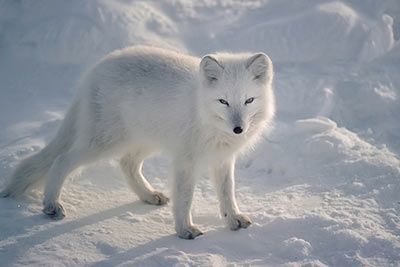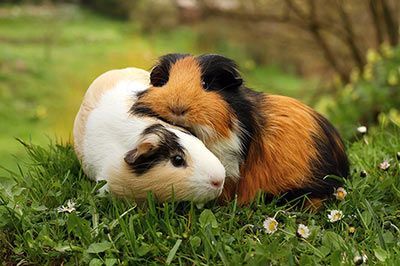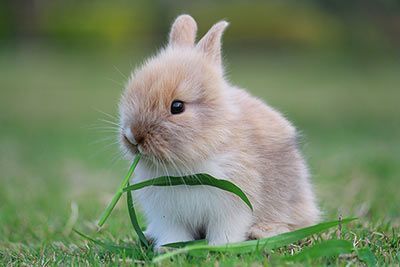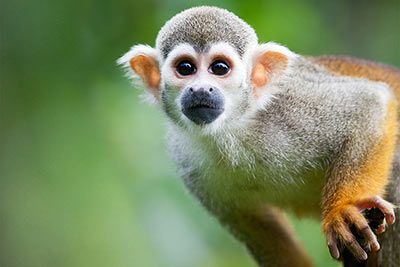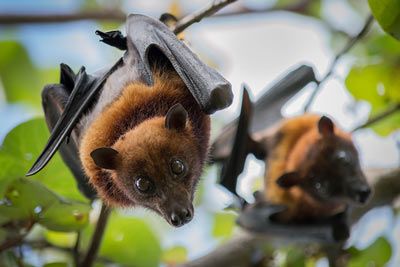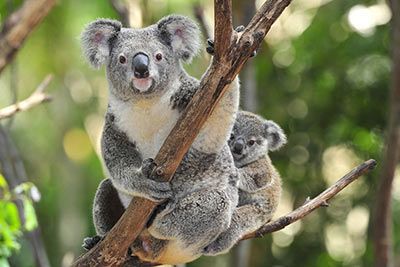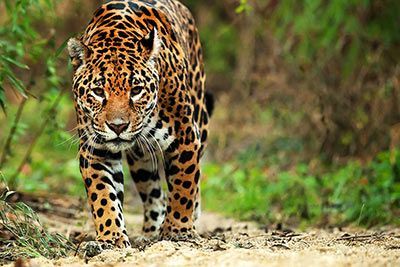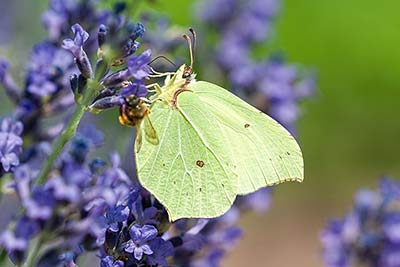Donkey
Donkey Facts
| Size | 35.4-63 inches (90-160 cm) (shoulder height) |
| Speed | Up to 15 mph (24 km/h) |
| Weight | 176-992 pounds (80-450 kg) |
| Lifespan | 15-40 years |
| Food | Grass |
| Predators | Foxes, wolves, lions |
| Habitat | Everywhere in the world |
| Order | Odd-toed ungulates |
| Family | Equidae |
| Scientific name | Equus asinus asinus (domesticated), Equus asinus (African), Equus hemionus (Asiatic), Equus kiang (Tibetan) |
| Characteristics | Ungulate with long ears, known for its „hee-haw" |
Main Characteristics
Donkeys are hoofed animals. They are the smallest members of the horse family. Their most striking features are their long ears, gray coat and white muzzle. They have a friendly and calm nature. They're considered stubborn. However, they are just cautious and won't let themselves be forced into anything.
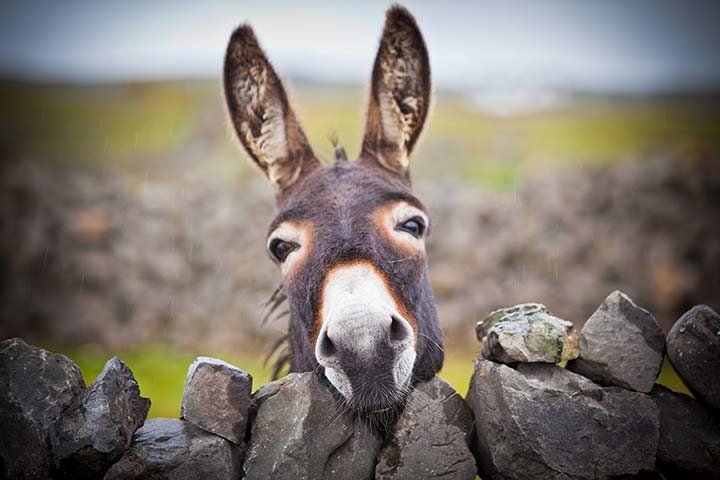
Origin and Evolution
The European domestic donkey is descended from the African ass. The species are closely related to each other. Researchers believe they were kept as pets in East Africa as early as 5,000-7,000 years ago. Donkeys, along with zebras, belong to the horse family.
Distribution and Habitat
Donkeys are found on all continents except Antarctica. Their natural habitat is the steppe.
Life Style
Donkeys aren't solitary animals. However, they do not form large herds like horses, but live in small groups.
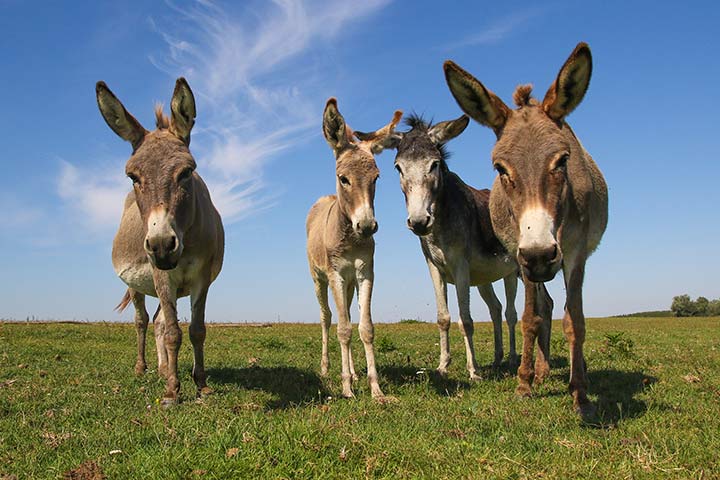
Anatomy and Appearance
Size and Weight
The size and weight of donkeys can vary a lot, since it heavily depends on its breed. Miniature donkeys grow to around 35 inches (90 cm) tall (shoulder height) and weigh 176-440 pounds (80-200 kg). Giant donkeys have a shoulder height of up to 62 inches (160 cm) and weigh 837-992 pounds (380-450 kg).
Ears
The ears of a domestic donkey are over 8 inches (20 cm) long. Their large ears help them to perceive sounds better. But: Why do donkeys have bigger ears than horses? There is a simple reason for this: In the wild, horses usually stand close to each other. If they want to communicate with their fellow species, they don’t have to have a good sense of hearing. Things are different with donkeys. While looking for food, they often wander away from the herd and graze at a significant distance from one another. The animals need a good sense of hreaing, if they want to communicate with each other.
Fur and Color
Donkeys often have a gray coat. But they can also be brown or black. Their belly is light gray or light brown to white. The skin on the muzzle and around the eyes is light gray to white.
Hooves
Donkeys hooves are perfectly adapted to the dry and firm ground of the steppe. Unlike horses, their narrow and sturdy hooves are more resistant and don't wear down easily on rough surfaces. However, donkeys may face challenges in humid climates as their hooves are prone to developing diseases on moist ground.
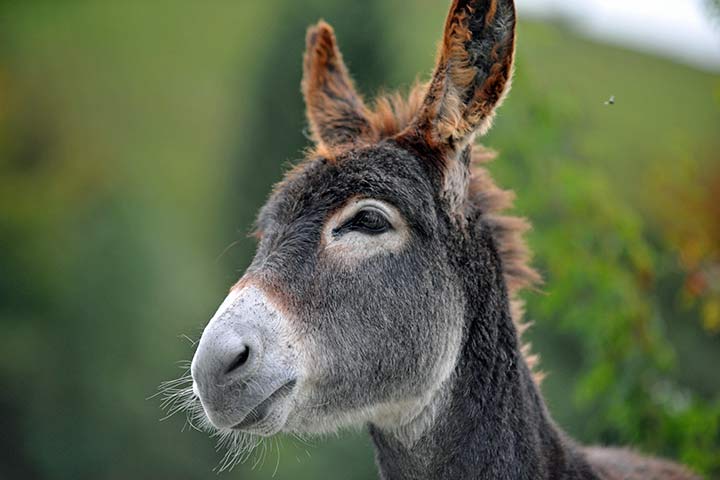
Diet
Donkeys are herbivores. Their diet primarily consists of sturdy, thorny plants like thistles and robust grasses in their natural habitat. They can also survive without water for a few days.
Feeding Donkeys
As pets, they mainly eat hay. If you pass a pasture and would like to feed one, please note: Donkeys shouldn't eat bread, vegetables, fruit or pasta. These foods quickly lead to life-threatening digestive problems. It is best to ask the owner whether and what can be fed.
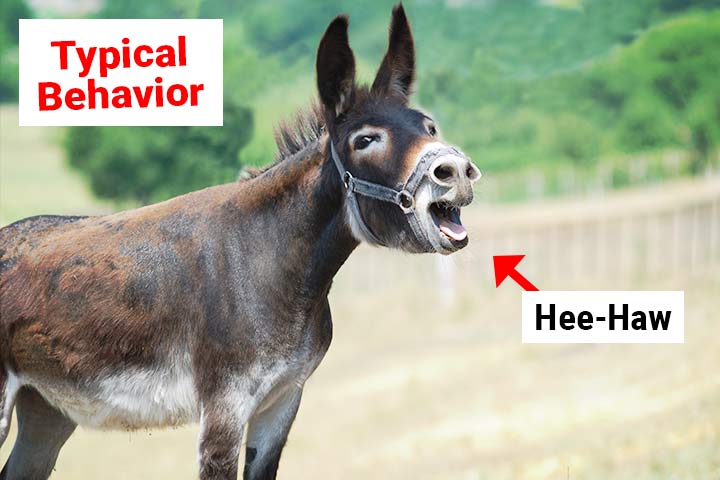
Behavior
Communication
• Hee-Haw
Why Do Donkeys Bray? Donkeys hee-haw to communicate with their fellow species. They also bray when they feel alone, when they don't feel well, when they are hungry or when there is danger.
• Volume
A donkey's call is around 80 decibels loud (as loud as a truck), sometimes even up to 120 decibels (plane taking off). It can be heard over 3 km away. In the wild, donkeys don't form large herds. In order to communicate over long distances, they have to call out loudly. Every donkey has a unique sound, so the animals can recognize each other, even without being able to see each other.
Social Behavior
Donkeys maintain close friendships. They show their affection by grooming each other's coat and nibbling on each other. They also take loving care of each other. For example, if a herd member is blind or lame, he or she is supported and guided by a friendly member of the herd.
Behavior in Case of Danger
„Stubborn as a donkey!“. This phrase is a way of expressing frustration towards someone who is hesitant to proceed, similar to how the animals react when confronted with an unfamiliar and potentially dangerous situation. Donkeys have a valid reason for their behavior as they can't run as fast as horses. So when there is danger, it is not a good plan to run away headlessly. They just stay where they are and start to “think” about their current situation. “Is it really that dangerous around here? “What is the ideal escape route?”
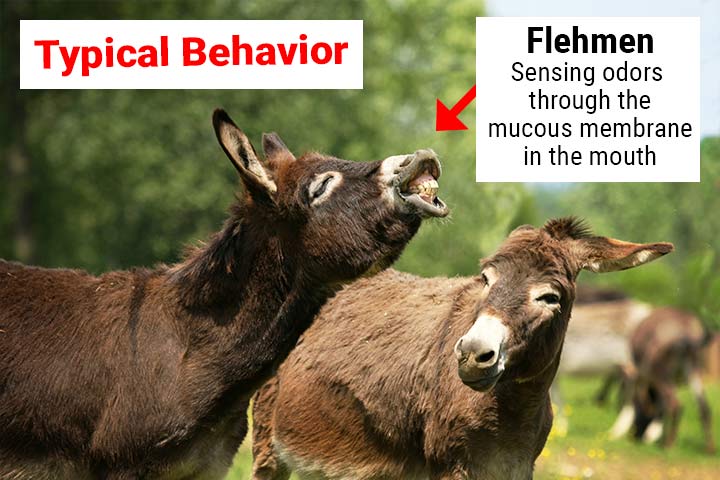
Senses and Abilities
Intelligence
Are donkeys smart? Most people don't think so. The animals are quite reserved and considered stubborn. That's why they may not seem intelligent. In fact, they are very clever. For example, when moving through unfamiliar terrain, they test different routes to find the safest path.
• Learning and Problem Solving
In 2023, the animal welfare organization “The Donkey Sanctuary” (UK) published a study on donkey intelligence. They found that the animals can learn and solve problems at the same pace as dolphins and dogs.
• Mathematical Skills
Donkeys have mathematical skills. Ok, they can't add numbers together or calculate multiples of a number. Nevertheless, they manage to estimate quantities quite accurately.
• Memory
Donkeys have a very good memory. Even after 25 years they remember other donkeys in the areas where they were living. They also remember for years people who have treated them particularly badly or particularly kindly.
Swimming
Can donkeys swim? Yes. However, they are a bit wary of water - as with many other things.
Life Expectancy
Donkeys live 15-40 years.
Enemies and Threats
Natural Predators
In Europe, wolves are considered the only natural enemies. The African species have lions as their enemy.
Pack Mule
In poorer countries, donkeys are still often used as draft or pack animals. They have to pull or carry so hard that their backs and joints are damaged. Therefore, they often only live 12-15 years.
Donkey Riding
Riding donkeys is very popular. Especially as a pastime on vacation, for example on the Greek island of Santorini. There, tourists can be carried by donkeys. 500 steps up from the harbor into the old town – and down again. They are also known as donkey taxis. Donkeys are very strong and robust, but they should never carry more than 20% of their own weight. For the donkeys on Santorini that is around 50 kg. A higher weight causes serious health problems like damaged back and joints. In the USA, women weigh an average of 170 pounds (77 kg) and men 200 pounds (90 kg). Way too much for a donkey. What are your thoughts on that? By the way, in Germany donkey riding is only permitted for children for this reason.
Donkey Skin
Every year approximately 4.8 million donkeys are slaughtered for a specific substance in their skin: “donkey-hide glue”. In China it is called “Ejiao”. Donkey skin is used in traditional Chinese medicine to relieve all kinds of illnesses. It is also found in expensive cosmetics - to slow down the aging of the skin. However, healing effects have never been scientifically proven. Would you use a donkey skin cream?

Reproduction
Gestation Period and Birth
Donkeys have a gestation period of around 12 months. A small baby donkey weighs 22-77 pounds (10-35 kg) when it is born.
Mules and Hinnies
Donkeys and horses can have offspring. In mules, the father is the horse and the mother is the donkey. With hinnies it's the other way around. If you want to learn more about the crossbreeds, read our article “Hinnies, Mules, Zonkeys and Zorses”.
Records
The Oldest
The oldest donkey in the world lived to the proud age of 54. It was a mare named Suzy who lived in New Mexico (USA).
The Longest Hair
The French Poitou donkey is known for its long, shaggy coat. It grows to 6 inches (15 cm) long and even longer.
The Tallest
Currently, the donkey stallion Romulus holds the record for the largest donkey. The name of its breed is “American Jack Mammoth”. He has an entry in the Guinness Book of Records with a shoulder height of 68 inches (172.72 cm) and a weight of 1,300 pounds (590 kg).
The Smallest
The smallest donkey is the miniature donkey KneeHi. Its name was created from “knee“ and „high”. It measures just 25.29 inches (64.2 cm) (shoulder height).
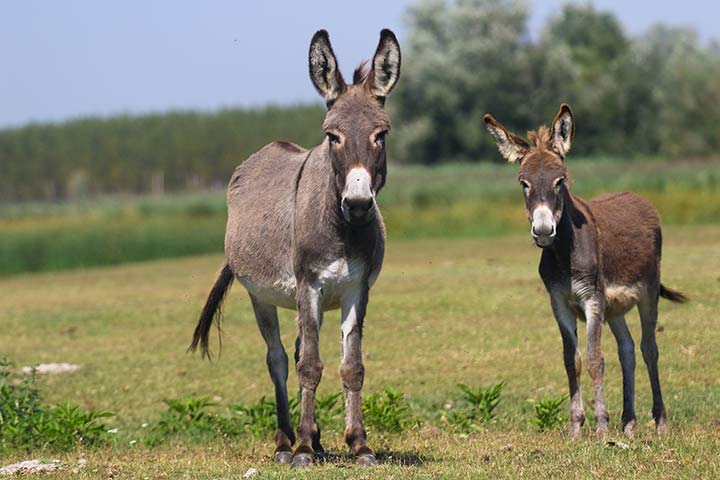
Donkeys as Pets
Keeping
If you want to buy a donkey, you should give it a species-appropriate home. For example, donkeys are not allowed to be kept alone. They are herd animals and need fellow species around them. They also need a lot of space so that they can move freely. Apart from being scratched and cuddled, a donkey also needs food and fresh water every day. The box has to be cleaned out and the manure taken away. In the best case scenario, a donkey costs 800 euros per year. It can live for 40 years and so it costs over 32,000 dollars (30,000 euros) over the course of its life.
Fun Facts
Donkeys Can Ease Stress
Donkeys are like therapists for nervous, fearful or injured animals. With their calm, gentle nature, they help other animals to calm down and regain their confidence. Therefore, donkeys are often kept with other animals.
Burrito
A burrito is a Mexican snack. It is a flatbread from wheat flour that is rolled out and filled with beans and other ingredients. The name comes from the Spanish word “burro”. It means donkey! The burrito is meant to represent a donkey's fully packed saddlebag.
The Donkey Is Related To:
- Horse
- Zebra













